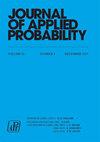瓦瑟尔斯坦空间双曲中心的随机梯度下降
IF 0.7
4区 数学
Q3 STATISTICS & PROBABILITY
引用次数: 0
摘要
我们提出并研究了一种新算法,用于计算欧几里得空间上绝对连续概率量的 2-Wasserstein 人口原点。所提出的方法可以看作是 2-Wasserstein 空间中的随机梯度下降过程,也是其中大数定律的一种表现形式。该算法旨在找到卡彻均值或临界点,并且可以 "在线 "实施,连续使用从群体规律中采样的独立且同分布的随机度量。我们为该算法提供了自然充分条件,使其在瓦瑟斯坦空间中几乎肯定收敛于群体原点,我们还引入了一个新颖的一般条件,确保卡彻均值的唯一性,此外,我们还能为预期最优性差距获得明确的参数收敛率。我们还研究了这一算法的迷你批处理版本,并讨论了我们的方法和结果可以应用的种群定律族的例子。这项工作拓展并深化了 Backhoff-Veraguas 等人(2022 年)早期版本中提出的观点和结果,其中在贝叶斯学习的背景下开发了该方法的统计应用(和数值实现)。本文章由计算机程序翻译,如有差异,请以英文原文为准。
Stochastic gradient descent for barycenters in Wasserstein space
We present and study a novel algorithm for the computation of 2-Wasserstein population barycenters of absolutely continuous probability measures on Euclidean space. The proposed method can be seen as a stochastic gradient descent procedure in the 2-Wasserstein space, as well as a manifestation of a law of large numbers therein. The algorithm aims to find a Karcher mean or critical point in this setting, and can be implemented ‘online’, sequentially using independent and identically distributed random measures sampled from the population law. We provide natural sufficient conditions for this algorithm to almost surely converge in the Wasserstein space towards the population barycenter, and we introduce a novel, general condition which ensures uniqueness of Karcher means and, moreover, allows us to obtain explicit, parametric convergence rates for the expected optimality gap. We also study the mini-batch version of this algorithm, and discuss examples of families of population laws to which our method and results can be applied. This work expands and deepens ideas and results introduced in an early version of Backhoff-Veraguas et al. (2022), in which a statistical application (and numerical implementation) of this method is developed in the context of Bayesian learning.
求助全文
通过发布文献求助,成功后即可免费获取论文全文。
去求助
来源期刊

Journal of Applied Probability
数学-统计学与概率论
CiteScore
1.50
自引率
10.00%
发文量
92
审稿时长
6-12 weeks
期刊介绍:
Journal of Applied Probability is the oldest journal devoted to the publication of research in the field of applied probability. It is an international journal published by the Applied Probability Trust, and it serves as a companion publication to the Advances in Applied Probability. Its wide audience includes leading researchers across the entire spectrum of applied probability, including biosciences applications, operations research, telecommunications, computer science, engineering, epidemiology, financial mathematics, the physical and social sciences, and any field where stochastic modeling is used.
A submission to Applied Probability represents a submission that may, at the Editor-in-Chief’s discretion, appear in either the Journal of Applied Probability or the Advances in Applied Probability. Typically, shorter papers appear in the Journal, with longer contributions appearing in the Advances.
 求助内容:
求助内容: 应助结果提醒方式:
应助结果提醒方式:


